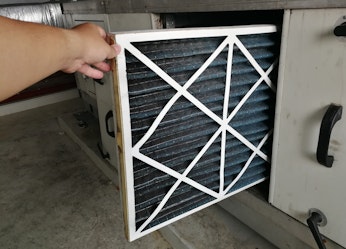

M|O Perspectives
Check back here for our thoughts on the latest developments in our industry.
COVID vs. HVAC: What Building Owners & Operators Should Know
Apr 09, 2020
While it may take years for scientists to uncover exactly how COVID-19 can spread through building systems, it’s better to be safe than sorry. We can all do our part to make sure our working and living environments are as safe and sterile as possible.
The World Health Organization (WHO) tells us that the COVID-19 virus spreads mostly through saliva droplets or discharge from the nose. This exchange takes place when an infected person coughs or sneezes, but even talking and breathing can release these droplets and particles.
Most droplets fall to the ground or stick to surfaces up 3 feet away. But some particles or aerosols, which act more like a gas, can travel through the air over longer distances. That’s where understanding and possibly adjusting your building’s heating, ventilation, and air conditioning systems can come into play.
People can social distance as much as possible, but owners and operators must look a little deeper to ensure that even their non-medical buildings are functioning at the highest level of safety during this unprecedented pandemic.
As consultants for the built environment, the engineering experts at Marx|Okubo can recommend a few suggestions for improving the health of your building — and its occupants.
Understand your building’s airflow path. How air circulates inside a building is critical, because this natural route is the primary carrier of heat, moisture, contaminant, and airborne particulates in any building. Sometimes providing the ability to adjust the route and introducing features that let us use more outside (virus free) air is a wise idea.
Start from the outside in. Increase outdoor air ventilation. While buildings have been getting more and more tightly sealed for energy conservation reasons, using outside air can make sense under certain conditions. Greater outside airflow can dilute or dissipate the concentrations of contaminants in the air. To eliminate recirculation, open minimum outdoor air dampers as high as 100%.
Change some settings. Disable any demand-controlled ventilation (DCV). The DCV system settings may be at odds with your attempts to introduce more fresh air into your building.
Consider Upgraded Filtration. Once you have disabled the DCV systems and are able to increase your outside air flow, consider upgrading filtration media to MERV-13 or higher. (MERV stands for Minimum Efficiency Reporting Value.) Higher MERV rated filter elements typically come with greater thickness; therefore, you will need to determine if your air handling system can physically accommodate the upgraded filters. In addition, be sure to check that your system can handle the added pressure drop across the upgraded filters.
Add supplementary cleaners. Place portable air cleaners with HEPA filters in certain rooms during events with high concentrations of people to add supplemental cleaning. To further disinfect high-risk communal spaces, investigate ultraviolet germicidal irradiation (UVGI) systems. UVGI systems can be added to HVAC equipment, if space allows, to further fight contamination.
Flush prior to Re-Occupancy. Consider implementing these procedures before occupants return to your buildings allowing sufficient time for the change to effectively reduce remaining airborne contaminants. If possible, also allow systems to run around the clock.
While none of us is certain of when, of course, we know that this pandemic will eventually end. Implementing these measures will give you and your building tenants the added confidence that they are living in and/or returning to a healthy and productive work environment.
If you have questions about making your building as healthy as possible right now—and in the future - Marx|Okubo can help. We can guide you through the questions you should be asking about HVAC and beyond. To discuss ways to assess and address your building's needs, contact our Director of Mechanical Engineering, Joseph Milam, at joseph_milam@marxokubo.com.

What we do.
- Owner's Representation
- Property Condition Assessment
- Project Management
- Constructability Reviews
- Repair | Reconstruction
- Facility Condition Assessment
- Construction Loan Monitoring
- Accessibility
- Building Enclosure
- Fire | Life Safety
- Mechanical | Electrical | Plumbing
- ESG | Sustainability & Resiliency
- Structural Engineering
- ASAP® - Automated Structure Alert Program
Marx|Okubo is a national architecture/engineering/construction consulting firm that works with real estate owners, investors and lenders—at every point of the property lifecycle—to evaluate their building projects, solve complex challenges and implement tailored solutions. We help clients understand their projects’ complexities, so they can make more informed decisions and, ultimately, mitigate their risk.




